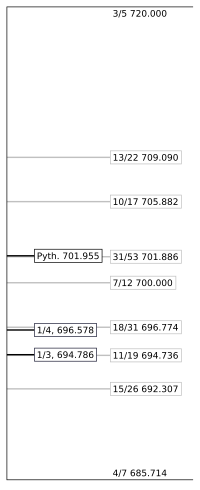31 equal temperament

Imagine you have a piano with 88 keys, and each key represents a different musical note. Now, traditionally, the piano is tuned using a system called 12 equal temperament, which means that the distance between each note is divided into 12 equal parts. This system works well for most music, but it has some limitations.
Now, think of creating a new piano where the distance between each note is divided into 31 equal parts instead of 12. This new system is called 31 equal temperament or 31-TET for short.
In 31-TET, each musical octave is divided into 31 evenly spaced notes. So, if you were to play a major scale on this piano, instead of the traditional 8 notes, you would have 15 different notes within an octave.
The benefit of using 31-TET is that it allows for more flexibility in playing different types of music. It can better represent microtonal music, which is music that incorporates tones that are not found in standard Western music.
For example, in standard Western music, we have 12 different notes, which include the white and black keys on the piano. But in some non-Western music traditions, there are notes that fall between these standard Western notes. These in-between notes are called microtones.
With 31-TET, we can better represent these microtones because the extra divisions between the notes allow for more precise tuning. This means that musicians can play a wider range of music styles and explore different tonal possibilities.
However, there are some challenges with using 31-TET. One challenge is that it can be difficult for musicians who are used to the traditional 12-note system to adjust to the new intervals and pitches. It requires relearning the fingerings and mental mappings of the instrument.
Another challenge is that instruments, like pianos, need to be specially designed and tuned to play in 31-TET. This means that most standard instruments cannot be easily adapted to this system without significant modifications.
Overall, 31-TET offers a unique way of playing and exploring music with more tonal possibilities than the traditional 12-note system. It allows musicians to experiment with microtonal music and create sounds that are not commonly heard in Western music.
Now, think of creating a new piano where the distance between each note is divided into 31 equal parts instead of 12. This new system is called 31 equal temperament or 31-TET for short.
In 31-TET, each musical octave is divided into 31 evenly spaced notes. So, if you were to play a major scale on this piano, instead of the traditional 8 notes, you would have 15 different notes within an octave.
The benefit of using 31-TET is that it allows for more flexibility in playing different types of music. It can better represent microtonal music, which is music that incorporates tones that are not found in standard Western music.
For example, in standard Western music, we have 12 different notes, which include the white and black keys on the piano. But in some non-Western music traditions, there are notes that fall between these standard Western notes. These in-between notes are called microtones.
With 31-TET, we can better represent these microtones because the extra divisions between the notes allow for more precise tuning. This means that musicians can play a wider range of music styles and explore different tonal possibilities.
However, there are some challenges with using 31-TET. One challenge is that it can be difficult for musicians who are used to the traditional 12-note system to adjust to the new intervals and pitches. It requires relearning the fingerings and mental mappings of the instrument.
Another challenge is that instruments, like pianos, need to be specially designed and tuned to play in 31-TET. This means that most standard instruments cannot be easily adapted to this system without significant modifications.
Overall, 31-TET offers a unique way of playing and exploring music with more tonal possibilities than the traditional 12-note system. It allows musicians to experiment with microtonal music and create sounds that are not commonly heard in Western music.
Related topics others have asked about:
